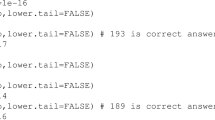Abstract
Learning-process statistics for absorbing Markov-chain models are developed by using matrix methods exclusively. The paper extends earlier work by Bernbach by deriving the distribution of the total number of errors, u-tuples, autocorrelation of errors, sequential statistics, and the expectation and variance of all statistics presented. The technique is then extended to latency derivations including the latencies of sequential statistics. Suggestions are made for using the sequential-statistic algorithm in a maximum-likelihood estimation procedure. The technique is important because statistics for very large absorbing matrices can be easily computed without going through tedious theoretical calculations to find explicit mathematical expressions.
Similar content being viewed by others
References
Atkinson, R. C., & Estes, W. K. In R. D. Luce, R. R. Bush, and E. Galanter (Eds.),Handbook of mathematical psychology. New York: Wiley, 1963, pp. 121–268.
Bush, R. R. Sequential properties of linear models. In R. R. Bush and W. K. Estes (Eds.),Studies in mathematical learning theory. Stanford: Stanford Univ. Press, 1959, pp. 215–227.
Bernbach, H. A. Derivation of learning process statistics for a general Markov model.Psychometrika, 1966,31, 225–234.
Bower, G. H. Application of a model to paired-associate learning.Psychometrika, 1961,26, 255–280.
Bower, G. H. & Trabasso, T. Concept-identification. In R. C. Atkinson (Ed.),Studies in mathematical psychology. Stanford: Stanford Univ. Press, 1964, pp. 32–94.
Kemeny, J. G., & Snell, L. J.Finite Markov chains. Princeton: D. Van Nostrand, 1960.
Millward, R. An all-or-none model for noncorrection routines with elimination of incorrect responses.Journal of Mathematical Psychology, 1964,1, 392–404.
Millward, R. Latency in a modified paired-associate learning experiment.Journal of Verbal Learning and Verbal Behavior, 1964,3, 309–316.
Nahinsky, I. D. Statistics-and-moment-parameter estimates for a duoprocess paired-associate learning model.Journal of Mathematical Psychology, 1967,4, 140–150.
Restle, F. Learning paired associates. In R. C. Atkinson (Ed.),Studies in mathematical psychology. Stanford: Stanford Univ. Press, 1964, pp. 116–172.
Suppes, P., Groen, G., & Schlag-Rey, M. A model for response latency in paired-associate learning.Journal of Mathematical Psychology, 1966,3, 99–128.
Author information
Authors and Affiliations
Additional information
The author is indebted to his students Thomas Wiekens and Richard Freund who were helpful in the development of this paper. Support was received for this work from Grant MH-11255 from the National Institutes of Mental Health.
Rights and permissions
About this article
Cite this article
Millward, R.B. Derivations of learning statistics from absorbing Markov chains. Psychometrika 34, 215–232 (1969). https://doi.org/10.1007/BF02289345
Received:
Revised:
Issue Date:
DOI: https://doi.org/10.1007/BF02289345




